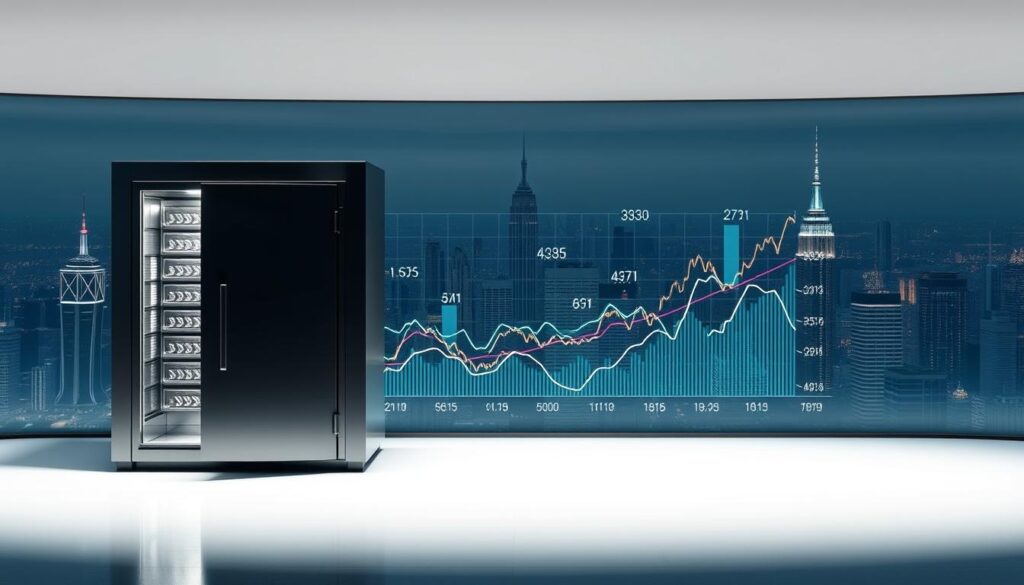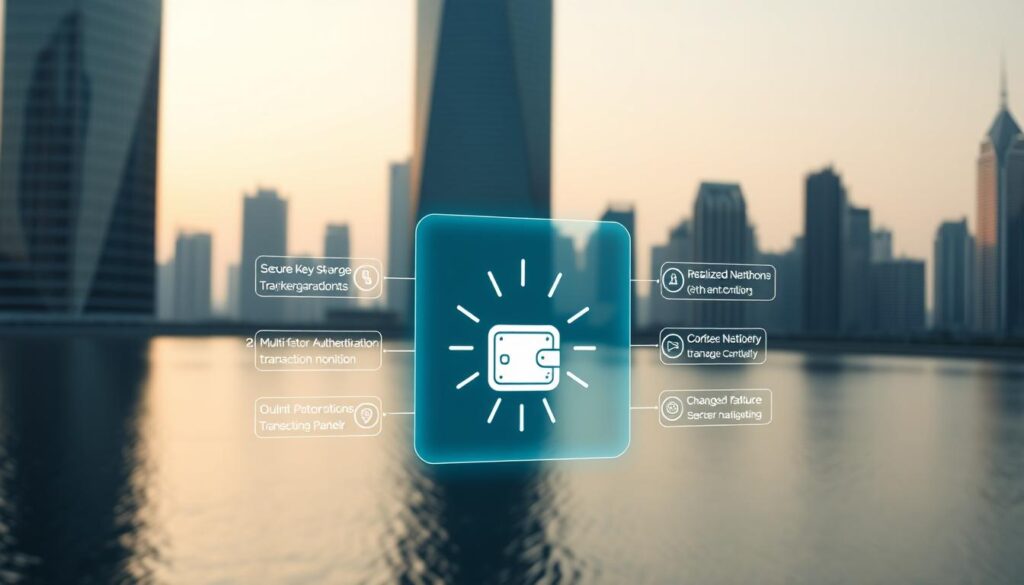Now Reading: Understanding Cryptocurrency custody institutional grade security
- 01
Understanding Cryptocurrency custody institutional grade security
Understanding Cryptocurrency custody institutional grade security

The world of digital value is growing fast. For large companies and financial firms, protecting these holdings is a top priority. It is no longer just a technical issue. It is a core business need.
The methods for safeguarding these resources have changed greatly. Early options were simple and self-managed. Today, we have advanced, regulated frameworks. These systems protect vast amounts of value.
Major investors face unique challenges. They must follow complex rules. The operational details are demanding. They require protection that matches traditional banking standards. Choosing the right partner is critical.
This decision directly impacts an organization’s future. It affects its ability to grow, stay compliant, and safeguard client property. Different entities have different needs. A hedge fund’s requirements differ from a traditional bank’s.
This guide provides a clear path forward. Each section builds a complete framework. It will help you evaluate and select the best solution for your specific situation.
Key Takeaways
- Protecting digital holdings is a strategic business imperative for large organizations.
- The landscape has evolved from basic self-management to sophisticated, regulated systems.
- Major investors face hurdles like regulatory compliance and operational complexity.
- Selecting the right management partner impacts scalability, compliance, and client safety.
- Different types of firms require tailored approaches to safeguarding their assets.
- This guide offers a structured framework for making an informed selection.
Introduction to Institutional Cryptocurrency Custody
What began as a specialized service has matured into a multi-billion dollar industry. The digital asset market now exceeds $3 trillion in value. This expansion includes thousands of crypto assets and tokenized securities.
Overview of market evolution and digital asset trends
Key events drove major adoption. The 2017 launch of Bitcoin futures on the Chicago Mercantile Exchange was significant. Spot Bitcoin ETF approvals in 2024 brought another wave of capital.
Recent surveys show promising trends. Two-thirds of institutional respondents plan to increase their digital asset allocation. The crypto custody market reached $3.28 billion globally by 2025.
Three main factors fuel this growth. Regulatory clarity from bodies like the SEC helps. Traditional finance giants like BNY Mellon and Fidelity entered the space. Corporate demand for treasury integration also drives expansion.
The importance of institutional-grade security
Large institutions require robust protection standards. Early crypto security measures were often basic. Today’s frameworks must match traditional banking safeguards.
Modern solutions go beyond simple key storage. They include compliance systems and insurance policies. Integration with conventional banking infrastructure is now essential.
Choosing the right custodian affects operational safety and compliance. This decision supports an organization’s long-term stability in the digital asset space.
The Rise of Digital Assets in Institutional Portfolios
The arrival of spot Bitcoin ETFs in early 2024 marked a pivotal moment for major financial players. This shift moved digital holdings from the fringe into mainstream investment strategies. The data now confirms a massive wave of capital allocation.
Growth trends and market statistics
According to recent data, the total assets under management in Bitcoin ETF funds nearly tripled in a single year. They grew from $50 billion in July 2024 to nearly $150 billion by July 2025. This represents a stunning 38% increase year-to-date.
Blackrock’s IBIT product stands out as a powerful case study. It accumulated a market cap of nearly $85 billion, making it one of the most successful ETF launches ever. This success demonstrates strong confidence from large-scale institutional investors.
This rapid growth has created a new, active client segment: ETF sponsors. These entities require specialized digital asset custody solutions that blend strict regulatory compliance with high operational efficiency.
Regulatory clarity, such as that provided by the CLARITY Act, has been a key catalyst. It reduced uncertainty and encouraged more institutions to move from a “wait and see” approach to active portfolio integration. This trend is expected to continue as the market matures.
Unique Challenges in Digital Asset Custody
Protecting digital wealth presents a distinct set of hurdles that traditional finance rarely encounters. These challenges make choosing the right safeguarding partner a critical decision for any serious organization.
The stakes are incredibly high, as failures can lead to total and irreversible loss.
Security vulnerabilities and cyber risks
Exchange-based protection models have shown serious weaknesses. The FTX collapse revealed a massive $10 billion loss of client funds due to commingling and misuse.
More recently, the Bybit incident in February 2025 saw hackers steal approximately $1.5 billion. They compromised an external platform and tricked staff into approving a malicious transaction.
Even specialized crypto custodians have faced issues. BitGo was involved in the 2016 Bitfinex hack. Prime Trust collapsed after losing private keys.
These events highlight the constant security risk that demands advanced controls.
Operational complexities and risk management hurdles
Self-management introduces significant operational complexity. It requires specialized hardware, secure facilities, and highly trained personnel.
The management of private keys is a fundamental risk. If keys are lost or stolen, the assets are gone forever. There is no central authority to reverse a transaction.
This creates a heavy burden of internal risk protocols. Organizations must build systems that prevent single points of failure.
Understanding these vulnerabilities is the first step toward building a resilient strategy for your digital assets.
Cryptocurrency custody institutional grade security – Core Features
The technological backbone of safeguarding digital holdings combines robust physical and cryptographic methods. These systems form a multi-layered defense designed to protect significant value.
Leading providers have standardized on a core set of technologies. This standardization has led to a dramatic improvement in safety records.

Cold Storage and Its Role in Asset Protection
Cold storage is the foundational layer for protecting digital property. It involves keeping the vast majority of assets in systems that are completely offline.
These air-gapped environments are physically isolated from internet-connected networks. This isolation prevents remote cyber attacks from reaching the holdings.
An example is the partnership between U.S. Bank and NYDIG. In this model, the sub-custodian manages the private keys within secure, offline storage.
Multi-Party Computation and Advanced Protocols
Multi-Party Computation (MPC) is an advanced cryptographic technology. It eliminates the risk of a single point of failure for private keys.
The protocol distributes key shares across multiple parties or systems. No single entity ever holds a complete key, making theft or misuse extremely difficult.
This approach, combined with other layers like segregation of duties and 24/7 monitoring, has proven highly effective. Successful breaches have been reduced by over 80% since 2022.
| Security Feature | Primary Function | Real-World Example |
|---|---|---|
| Air-Gapped Cold Storage | Keeps assets offline and immune to remote hacking. | U.S. Bank & NYDIG partnership for offline storage. |
| Multi-Party Computation (MPC) | Distributes key shares to prevent a single point of failure. | Leading custodian platforms using MPC protocols. |
| Independent Audits (SOC 1/2) | Verifies that security controls are operational and effective. | Regular third-party audits of a custodian‘s systems. |
These core features create a resilient architecture. They provide the high level of protection that major organizations require for their digital asset portfolios.
The Impact of Regulation and Compliance on Custody Solutions
Regulatory frameworks have become the bedrock of trust in digital asset protection. These rules separate professional solutions from basic options. They create a safe environment for major participants.
Regulatory frameworks in the United States
In the US, trusted providers operate under strict oversight. The New York Department of Financial Services (NYDFS) sets clear rules. National banks answer to the Office of the Comptroller of the Currency (OCC).
These agencies require annual examinations and detailed record-keeping. NYDFS guidance states that client assets must remain client property. Providers cannot make false claims about their services.
How compliance builds investor trust
Strong compliance controls demonstrate serious commitment. When Anchorage Digital faced issues, the OCC required immediate improvements. This active oversight protects investors.
Asset segregation is critical for client safety. Rules mandate that client holdings stay separate from the provider’s assets. This prevents loss if the firm encounters trouble.
International standards like the UK’s Client Asset Sourcebook (CASS) show global alignment. These frameworks ensure clear ownership records and proper wallet separation.
Leading providers like Coinbase Custody and BNY Mellon maintain prestigious licenses. This regulatory standing gives institutions confidence in their choice of custodian.
Comparing Traditional Custodians and Crypto-Native Providers
Major investors must weigh the advantages of century-old banking custodians against innovative crypto-native providers. Each approach offers distinct benefits for protecting digital holdings.
Legacy banking versus specialized crypto solutions
Traditional banks bring deep experience to digital asset protection. U.S. Bank has safeguarded securities for over 150 years. Their partnership with NYDIG extends this legacy to digital holdings.
These established custodians provide integrated reporting for both traditional and digital assets. This solves a major gap for diversified portfolios. Their mature risk management systems offer strong regulatory oversight.
Crypto-native custodians like Anchorage and BitGo focus exclusively on digital assets. They develop advanced technological solutions. Multi-party computation and specialized wallets are their strengths.
However, these providers have faced operational challenges. Technology vulnerabilities and varying regulatory oversight remain concerns. Traditional banks offer more established infrastructure and capital reserves.
| Provider Type | Key Strengths | Considerations |
|---|---|---|
| Traditional Bank Custodians | 150+ years experience, integrated reporting, strong regulatory oversight | May have slower adoption of latest crypto technologies |
| Crypto-Native Providers | Advanced cryptographic solutions, specialized focus, rapid innovation | Varying regulatory standards, operational history concerns |
| Hybrid Approach | Combines banking stability with crypto expertise | Partnership models like U.S. Bank and NYDIG |
The choice depends on an organization’s specific needs. Portfolio composition and regulatory requirements guide the selection. Both models continue evolving to serve major institutions effectively.
Optimizing Custody Solutions for Institutional Investors
For large-scale financial entities, selecting a safeguarding partner requires a rigorous evaluation of operational and protective benchmarks. This process ensures the chosen framework supports both safety and business agility.
A thorough assessment moves beyond basic features. It delves into the provider’s core risk management philosophy and technological resilience.
Key operational and security benchmarks
Leading providers implement enterprise-level measures. These include robust encryption and infrastructure with built-in redundancy.
Disaster recovery plans and strict controls for key management are essential. Regular oversight ensures these protocols remain effective.
Compliance is another critical layer. Know-your-customer (KYC) and know-your-transaction (KYT) protocols establish fund provenance.
Sophisticated systems develop client baselines for normal activity. They continuously monitor for unusual transactions, escalating any that need extra scrutiny.
Operational efficiency is a key differentiator. Real-time API integrations connect custody solutions to existing treasury systems.
This enables automated reporting and instant payroll processing. It also allows for foreign exchange optimization and controlled access to decentralized finance protocols.
| Evaluation Dimension | Critical Components | Impact on Investors |
|---|---|---|
| Technology & Security | Encryption, redundancy, disaster recovery, key controls | Ensures asset safety and long-term viability of the custody solution. |
| Compliance & Monitoring | KYC/KYT/AML frameworks, client baselines, transaction monitoring | Builds trust and mitigates regulatory risk for the investors. |
| Operational Integration | Real-time APIs, automated reporting, treasury connectivity | Enhances workflow efficiency and provides seamless access to solutions. |
By applying these benchmarks, organizations can select a custodian that enhances their digital strategy. The right custody solutions provide a foundation for secure growth.
Risk Management and Insurance in Custody Practices
Beyond technical safeguards, financial protections form a critical safety net for institutional holdings. A robust risk management framework combines preventive measures with financial backstops like insurance and capital reserves.

This layered approach ensures that client assets are protected even in unforeseen circumstances.
Evaluating insurance policies and capital reserves
Leading custodians carry substantial insurance policies, often valued from $75 million to over $320 million. These typically cover commercial crime and theft from cold storage.
Providers like Coinbase and BitGo partner with major insurers, including Lloyd’s of London. However, the fine print matters greatly for effective risk management.
Institutions must verify the exact coverage applicable to their assets. They need clear definitions of liability for holdings in hot versus cold wallets.
It is also vital to identify policy exclusions, such as losses from smart contract bugs or authorized but mistaken transfers.
Bank custodians offer an additional layer of safety through regulatory capital requirements. They must hold significant reserves under Basel standards.
This provides a solid buffer to absorb potential losses. Banks undergo regular capital adequacy assessments, a practice not historically required of single-purpose crypto firms.
The diverse balance sheets of established banks make sudden bankruptcy far less likely. This stability supports long-term institutional investment strategies.
If problems occur, banks have the resources to make customers whole. Regulators can also facilitate an orderly transfer of custody to another institution.
| Protection Type | Key Consideration | Due Diligence Question |
|---|---|---|
| Insurance Policy | Covers specific perils like theft | What are the exclusions and coverage limits for our assets? |
| Capital Reserves | Provides a financial buffer for solvency | What is the custodian’s capital adequacy ratio and financial health? |
A thorough review of both insurance and capital positions is essential for complete risk management. It ensures your client assets have multiple layers of financial protection.
Technological Innovations Driving Custody Evolution
Modern protection systems combine multiple layers of defense to create resilient digital asset management. These advanced frameworks have transformed basic key storage into sophisticated infrastructure.
Advanced security measures and disaster recovery
Leading providers deploy comprehensive security stacks. Air-gapped cold storage keeps most assets completely offline. This approach prevents remote attacks.
Multi-Party Computation ensures no single entity holds complete private keys. Hardware Security Modules provide tamper-resistant cryptographic processing.
Continuous audits verify that security controls remain effective. Regular penetration testing identifies potential vulnerabilities. This multi-layered technology reduces operational risk dramatically.
Integration of blockchain analytics and internal controls
Blockchain analytics enhance monitoring capabilities. Systems develop client baselines for normal transaction patterns. They continuously scan for unusual activities.
Advanced monitoring provides 24/7 surveillance with automated alerts. This infrastructure detects potential security incidents in real time. It escalates transactions that deviate from expectations.
Disaster recovery frameworks include tested protocols for worst-case scenarios. Geographically distributed backup systems ensure asset recovery. These controls make digital asset protection both secure and efficient.
Integration Strategies with Traditional Banking Systems
The true power of modern asset protection lies in its ability to connect seamlessly with an organization’s existing financial systems. This integration transforms a standalone service into a core operational capability.

Real-time API integrations and automated reporting
Leading providers offer real-time API integration to accelerate treasury workflows. These systems enable instant payroll processing and foreign exchange optimization.
Automated reporting dashboards provide immediate visibility into positions and transaction history. This eliminates manual data aggregation and reduces errors.
Qualified bank providers offer a significant advantage. They consolidate traditional and digital holdings on unified statements. This provides a single view of an entire portfolio.
Seamless access to these tools is critical for efficient management. Direct connectivity to fiat gateways allows for smooth conversion between currencies.
Built-in compliance reporting ensures institutions meet regulatory demands. This technology is essential for businesses handling high transaction volumes.
| Integration Feature | Primary Benefit | Operational Impact |
|---|---|---|
| Real-time APIs | Programmatic access and automation | Enables instant payroll and settlement |
| Unified Reporting | Consolidated portfolio view | Simplifies management and reconciliation |
| Direct Fiat Connectivity | Efficient currency conversion | Reduces operational overhead |
This level of integration ensures digital asset operations enhance, rather than complicate, existing financial systems.
Navigating the Landscape of Institutional Custody Providers
Choosing the right partner for safeguarding digital holdings requires careful navigation of a complex provider landscape. Organizations need a systematic approach to evaluate potential custodians effectively.
This evaluation transforms an overwhelming task into a structured process. It ensures alignment with operational, regulatory, and strategic requirements.
Evaluation criteria for selecting a custodian
Begin by verifying regulatory standing. A qualified custodian should hold prestigious licenses like US OCC charters or Swiss FINMA authorization. These credentials demonstrate compliance commitment.
Security infrastructure forms the foundation of protection. Ask specific questions about cold storage implementation and Multi-Party Computation protocols. Independent SOC audit completion is essential.
Financial safeguards require careful assessment. Request exact insurance coverage amounts applicable to your asset levels. Understand liability definitions for different storage types.
Integration capabilities impact operational efficiency. Evaluate API functionality and real-time reporting dashboards. Compatibility with existing treasury systems is crucial.
Fee structures typically range from 0.04% to 0.50% annualized. High-volume clients often have negotiation opportunities. Remember that the cheapest option rarely offers optimal protection.
For organizations targeting emerging markets, prioritize providers with local expertise. Look for in-market legal counsel and established banking relationships. This ensures efficient local currency operations.
This comprehensive framework guides your selection process. It helps identify custody solutions that meet both current needs and future growth objectives.
Global Perspectives and Trends in Institutional Crypto Custody
The global landscape for safeguarding digital holdings is rapidly diversifying. Emerging markets present unique challenges and opportunities for growth.
This $3.28 billion industry is no longer confined to established financial hubs. It is expanding into new regions with different needs.

Insights from emerging markets and cross-border considerations
Regions like Africa and Latin America show immense potential. However, they face hurdles like fragmented banking systems.
There is a strong need for reliable USD liquidity and secure currency exchange points. Providers must offer clear audit trails for cross-border flows.
This complex environment demands specialized knowledge. Top-tier custodians with local expertise are best positioned to succeed.
The future roadmap for digital asset custody
The industry is moving towards deeper integration. Digital assets are becoming part of core treasury operations.
We expect more traditional banks to enter this space. Regulatory frameworks will likely harmonize across borders.
Services will evolve beyond simple storage. They will offer programmable features and seamless connections to global payment networks.
| Market Region | Primary Challenge | Key Opportunity |
|---|---|---|
| Established Markets (e.g., US, EU) | Navigating complex, mature regulatory frameworks | Integrating with existing, large-scale financial infrastructure |
| Emerging Markets (e.g., Africa, LatAm) | Overcoming banking fragmentation and liquidity gaps | Capturing first-mover advantage in a high-growth environment |
| Global Trend | Standardizing compliance across jurisdictions | Building scalable, interconnected custody infrastructure |
This evolution highlights the strategic importance of this market. Choosing a partner with a global vision is crucial for long-term success with cryptocurrencies.
Conclusion
In today’s evolving financial landscape, robust digital asset protection serves as foundational infrastructure rather than optional security. The right custody solution directly impacts an organization’s ability to maintain regulatory compliance and protect client assets.
Modern protection frameworks require cold storage, multi-party computation, and comprehensive insurance. These features create the baseline for effective security and risk management.
Evaluating providers holistically ensures alignment with both current needs and future growth. Consider integration capabilities, regulatory standing, and market expertise when selecting services.
The landscape continues to evolve with technological innovation and regulatory development. Choosing a partner committed to industry standards enables confident deployment of digital asset strategies.
FAQ
What is the main difference between a traditional custodian and a crypto-native provider?
Traditional custodians, like large banks, are experts in safeguarding stocks and bonds. Crypto-native firms specialize in protecting digital assets using advanced technology like multi-party computation and secure cold storage protocols designed for the unique risks of the blockchain environment.
How does cold storage protect my digital assets?
Cold storage keeps private keys completely offline, disconnected from the internet. This method isolates assets from online threats like hacking. It is a foundational security measure used by top custodians to manage risk for institutional investors.
Why is regulatory compliance so important for a qualified custodian?
Strong compliance with frameworks ensures a custodian operates with rigorous internal controls and reporting standards. This builds essential trust with clients, demonstrating a commitment to legal obligations and the safe management of client assets.
What should I look for in a custodian’s insurance policy?
Evaluate the scope of coverage, policy limits, and the insurer’s reputation. A robust policy should protect against theft, loss, and other operational risks. It is a critical component of a comprehensive risk management strategy.
How do advanced security protocols like MPC enhance safety?
Multi-Party Computation (MPC) splits a private key into several pieces, distributed among multiple parties. A transaction requires collaboration, eliminating any single point of failure. This technology significantly reduces vulnerability to cyber risks.
Can institutional custody solutions integrate with my existing banking infrastructure?
Yes. Leading providers offer API integrations that enable seamless connectivity with traditional banking systems. This allows for automated reporting, transaction monitoring, and streamlined operations, simplifying the complexity of managing digital assets.














